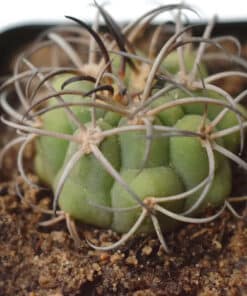Ferocactus Horridus cactus
Ferocactus Horridus cactus Description: F. horridus “brevispinus” is a solitary fast growing little barrel cactus with quite short and stocky cental spine one (not enough to call it curved!) This plant becomes very nice when a bit older.
Stem: Round to elongated dark green 25-40 cm in diameter 40-100 tall.
Central spines: Has a very short but strong, recurving brownish-grey, large central spine. Slightly hooked or just with a slight kink at the end. Very dark red to almost black that can take a chalky colour ageing.
Radial spines: 7-10 short, straight but stout
Flower: Orange/Yellow and have orange or red midviens.
Fruit: Lemon yellow.
Seeds: Black. shining.
Cultivation: F. horridus is a summer-growing and pretty easy species thought slow to start. It is suited for any rich, well drained soil such us clay, pumice, lava grit, and only a little peat or leaf-mould. If potted, repot preferably in the spring, if their roots become cramped. Generally, they should be repotted every other year in order to provide fresh soil. However, this doesn’t necessarily mean they’ll need larger containers. Fill about a quarter of the pot with broken crocks, gravel, etc. to promote good drainage. After repotting, do not water for a week or more. Water regularly during the aestival growth cycle (this plant need plenty of water, but do not overwater and let their soil dry out between waterings), and also needs to be avoided wetting the body of this plant while it is in sunlight. A wet cactus in the sun light can cause sun burning which can lead to scares or even fungal infections and death, keep rather dry in winter. No water should ever be allowed to stand around the roots. Feed with a high potassium fertilizer in summer.
Exposure: Outside they need a bright exposure, full sun or half shade in summer if the location is exceedingly hot or bright, inside needs bright light, and some direct sun. It can tolerate moderate shade, and a plant that has been growing in shade should be slowly hardened off before placing it in full sun as the plant will be severely scorched if moved too suddenly from shade into sun.
Frost Tolerance: Light frost protection required for safe cultivation, but can tolerate sporadic light frost. This plants need a period of cool rest in winter to produce flowers abundantly.
Diseases and pests: Watch for infestations of mealybug, scale insects and spider mite.
Plant in good conditions will start to bloom when reach the diameter of only 15-18 cm.
Propagation: Seeds are the only way of reproducing
| Color | Green |
|---|---|
| Growth Pattern | Globular |
| Ideal location | partial sun with white net |
| Origin Country | India |
Be the first to review “Ferocactus Horridus cactus” Cancel reply
You must be logged in to post a review.



















Reviews
There are no reviews yet.